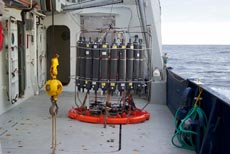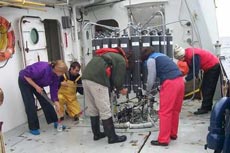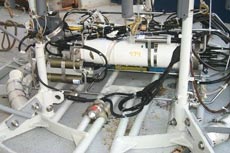


The Project
|
Daily JournalDecember 4, 2004: Scientists and Their Tools
On December 3, we lowered a CTD, an instrument that measures conductivity, temperature, and depth as it collects water samples. On this expedition, the scientists are specifically interested in measuring amounts of barite in the sea water. What is barite and why are scientists interested in it? Barite is a mineral that has commercial uses; however, more importantly, barite serves as a record of changes in the ocean. Understanding how barium moves through cold seeps is the key to understanding how oceans change. Studying the record of how oceans have changed in the past helps scientists make predictions about how climate changes will affect oceans in the future. For example, California current has great economic value to the fishing industry. Scientists look at how climate changes like global warming might affect the productivity of these ocean resources. Environmental Science
Math Catch of the Day:The CTD is attached to the bottom of the rosette. There are 24 one liter bottles on the rosette that collect water samples at various depths.
top left: CTD Next episode: Recovering the Mooring
|





